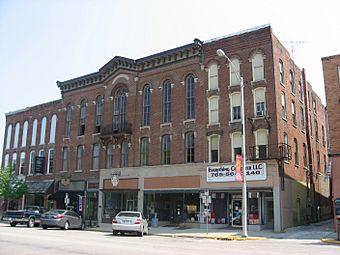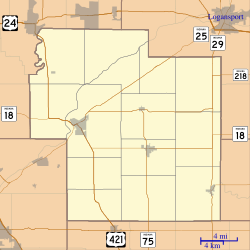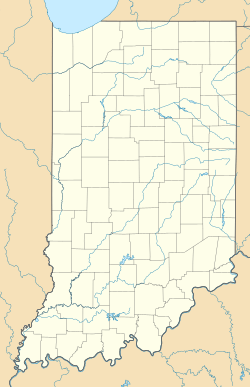Delphi Courthouse Square Historic District facts for kids
Quick facts for kids |
|
|
Delphi Courthouse Square Historic District
|
|

Buildings on the eastern side of the square
|
|
| Location | Roughly bounded by Monroe, s. side of Main, w. side of Market and Indiana Sts., Delphi, Indiana |
|---|---|
| Area | 23 acres (9.3 ha) |
| Architect | Dunlap, Elmer; et al. |
| Architectural style | Italianate, Classical Revival |
| NRHP reference No. | 10000120 |
| Added to NRHP | March 31, 2010 |
The Delphi Courthouse Square Historic District is a special area in Delphi, Indiana. It covers about 23 acres (about 9 hectares) and is filled with many old buildings. This district was added to the National Register of Historic Places in 2010. This means it's recognized as an important historical place! You'll find buildings here with cool styles like Italianate architecture and Classical Revival architecture. Some were even designed by famous architects like Elmer Dunlap.
Discovering Delphi's Past
How Delphi Began
The town of Delphi started thanks to William Wilson. He gave 100 acres of land along Deer Creek. This spot was great because of the Indian mill sites nearby. In May 1828, Samuel Milroy helped make Delphi the county seat. Early on, the town grew slowly because of nearby swamps.
First Settlers Arrive
Henry Robinson was one of the first people to settle here. In 1825, he and his family built the first log cabin. It was just south of Deer Creek, on a spot later called "Robinson's hill." Daniel Baum and his family also built a cabin there. They opened the first tavern, a popular stop for travelers.
Travel and Trade Routes
The Wabash River, located north and west of Delphi, was a key travel route. French Canadian traders and settlers from Ohio and Kentucky came here. They wanted land and to trade along the Wabash River. Ephraim Chamberlain bought the first piece of land in this area in 1824.
Canals and Railroads
In 1826, the Wabash and Erie Canal opened. This canal helped Delphi trade with places to the east and southwest. The town started to grow much faster. But when railroads came along, the canal became less important. The canal stopped working around 1850. This happened after an aqueduct over Deer Creek collapsed.
The railroad arrived in Delphi in 1856. Several important railroad lines passed through Delphi. These included the Norfolk and Western, Monon, and the Louisville and Nashville Railroad. Later, an electric train line, called an interurban, came through in 1904. These interurban lines eventually closed when motor buses became popular.
Cool Buildings to See
Many buildings in the Delphi Courthouse Square Historic District are very old and special. They are called "contributing" structures. This means they help make the district historically important. Some buildings are rated 'O', meaning they are so important they could be listed on their own. 'N' means they are above average. 'R' means they are good examples that fit well with other buildings in the area.
Here are some of the interesting buildings you can find:
Along West Monroe Street
- 118 West Monroe Street: A beautiful house built around 1885 in the Queen Anne style. This one has an 'O' rating!
Along West Franklin Street
- 010 West Franklin Street: A commercial building from around 1855. It shows off the Italianate style and has an 'O' rating.
- 115 West Franklin Street: The Ives Building, another Italianate style building from about 1885. It also has an 'O' rating.
Along East Franklin Street
- 201 East Franklin Street: The RUFFIN-ROBINSON House, built around 1887. It's a great example of Queen Anne style and has an 'O' rating.
Along West Main Street
- 101 West Main Street: The Carroll County Courthouse. This is a very important building in the district.
- 112 West Main Street: The Holt-Rinehart Commercial Building, an Italianate style building from 1857. It has an 'O' rating.
Along East Main Street
- 102 East Main Street: The Odd Fellows Commercial Building, built in 1881. It shows the Second Empire style and has an 'O' rating.
- 107-109 East Main Street: Another I.O.O.F. Commercial Building from 1874. It's in the Victorian Renaissance style and has an 'O' rating.
- 112 East Main Street: The Dimmick Wollver Commercial Building, an Italianate building from around 1865. It has an 'O' rating.
- 113-115 East Main Street: The Carl Brother's Block Commercial Building, built in 1876 in the Italianate style. It has an 'O' rating.
- 123 East Main Street: The A.T. Bowen Bank Commercial Building, an Italianate building from around 1840. It has an 'O' rating.
- 124 East Main Street: The Niewerth Commercial Building, an Italianate building from 1874. It has an 'O' rating.
- 222 East Main Street: The Public Library, built around 1905 in the Neo-Classic style. It has an 'O' rating.
- 302 East Main Street: The First Presbyterian Church, built in 1909 in the Neo-Gothic style.
Along South Washington Street
- 105-107 South Washington Street: The Old City Hall-Opera House. This is another very important building.
- 109 South Washington Street: A commercial building from 1864 in the Italianate style. It has an 'O' rating.
- 120 South Washington Street: A Gas Station Commercial Building from around 1920 in the English Domestic style. It has an 'O' rating.
- 210-212 South Washington Street: The Lathrop-Kerlin Commercial Building, a Queen Anne style building from around 1880. It has an 'O' rating.
- 215 South Washington Street: The Masonic Temple (Delphi), an Italianate building from around 1875. It has an 'O' rating.
- N.A. South Washington Street: The Courthouse, built in 1917 in the Renaissance Revival style. It has an 'O' rating.
Along South Indiana Street
- 219 South Indiana Street: The Smith-Darragh House, a Greek Revival style house from 1840. It has an 'O' rating.
Along South Union Street
- 219 South Union Street: The Dougan-Davis House, an Italianate style house from around 1865. It has an 'O' rating.
Along North Market Street
- 712 North Market Street: The Gros House, an Italianate style house from around 1860. It has an 'O' rating.
Images for kids













